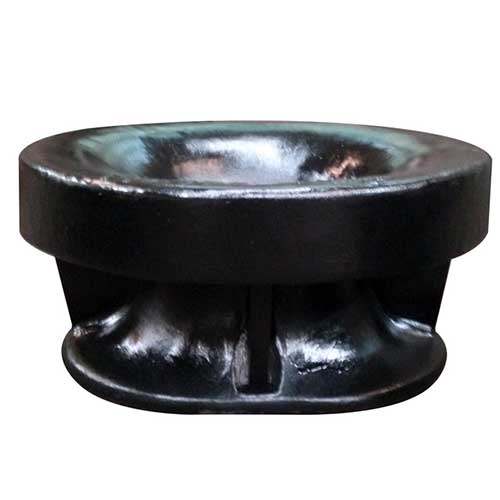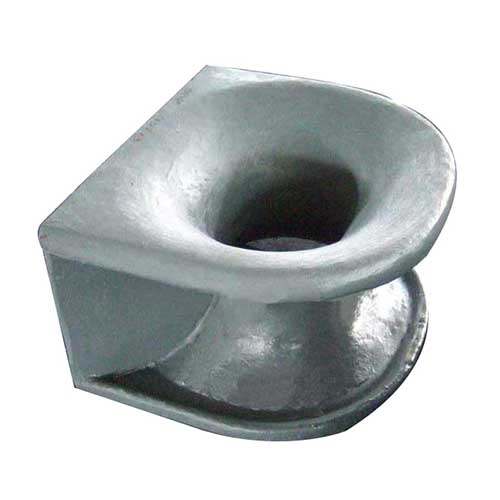What are Advanced Materials in the Manufacturing of Mooring Chocks
Table of Contents
Mooring chocks play a pivotal role in ensuring the secure mooring of vessels in the maritime industry. Traditionally, these components were made using standard cast steel or cast iron. However, with the increasing demands of modern marine operations, advanced materials have emerged as key contributors to the performance, durability and safety of mooring chocks. This article explores the advanced materials revolutionizing mooring chock manufacturing and their benefits.

What are Traditional Materials in Mooring Chock Manufacturing
This chart highlights the key traditional materials used in mooring chock manufacturing, their advantages, and their limitations, helping to understand their roles in maritime applications.
| Material | Properties | Advantages | Disadvantages |
| Cast Iron | High strength, durability, good wear resistance. | Affordable, easy to cast into complex shapes. | Prone to corrosion in marine environments; brittle. |
| Carbon Steel | Strong and tough, with high tensile strength. | Excellent load-bearing capacity; cost-effective. | Susceptible to rust if not coated or maintained properly. |
| Stainless Steel | Corrosion-resistant, durable, and aesthetically appealing. | Long lifespan; low maintenance in marine conditions. | Higher cost compared to other materials. |
| Bronze | Corrosion-resistant and good wear properties. | Ideal for harsh marine environments; aesthetic appeal. | Expensive; lower tensile strength than steel. |
| Aluminum Alloys | Lightweight and resistant to corrosion. | Easy to handle; excellent for small and mid-sized vessels. | Lower strength compared to steel; less durable under high loads. |

Key Advanced Materials in Mooring Chock Manufacturing
1. High-Strength Alloys
High-strength steel alloys, such as high manganese steel and chromium-molybdenum steel, are widely used in modern mooring chock manufacturing. These materials offer:
- Enhanced Tensile Strength: Withstand high loads and reduce the risk of deformation under extreme stress.
- Corrosion Resistance: Chromium-based alloys, in particular, provide superior resistance to marine corrosion, extending the lifespan of the chocks.
- Impact Resistance: The high toughness of these alloys ensures that the chocks can endure sudden mechanical shocks and impacts.
2. Ductile Iron
Ductile iron, also known as nodular cast iron, combines the advantages of traditional cast iron with superior mechanical properties. Key benefits include:
- High Elasticity: Allows the chock to absorb significant stress without cracking.
- Cost Efficiency: Offers a balance between performance and affordability compared to high-end alloys.
- Ease of Machining: Simplifies manufacturing while maintaining structural integrity.
3. Composite Materials
The introduction of composite materials in mooring chock production has provided innovative solutions for specialized applications. For instance:
- Carbon Fiber Composites: Known for their lightweight properties, these are suitable for applications where weight reduction is critical without compromising strength.
- Glass-Reinforced Plastics (GRP): Ideal for small vessels or yachts due to their corrosion resistance and ease of customization.
- Hybrid Composites: Combining different fibers, these materials optimize performance for niche marine applications.
4. High-grade Stainless Steel
Modern mooring chocks often incorporate advanced grades of stainless steel, such as 316L and duplex stainless steel. These materials offer:
- Exceptional Resistance to Chloride-Induced Corrosion: Essential in saltwater environments.
- High Load-Bearing Capacity: Makes them suitable for heavy-duty marine operations.
- Aesthetic Appeal: Polished stainless steel is often used in luxury vessels for its visual appeal alongside functionality.
5. Titanium Alloys
Titanium alloys are increasingly used in high-end applications due to their:
- Exceptional Strength-to-Weight Ratio: Lightweight yet capable of handling high loads.
- Corrosion Resistance: Unmatched durability in saltwater environments.
- Longevity: Provides a longer service life than most traditional materials.
6. Advanced Coatings and Surface Treatments
While base materials are crucial, the application of advanced coatings further enhances performance. Examples include:
- Thermal Sprayed Coatings: Improve wear resistance and reduce friction during line handling.
- Polymer Coatings: Offer additional protection against salt spray and UV radiation.
- Nanocoatings: Provide superior hydrophobic properties and prevent biofouling, reducing maintenance needs.

Performance Benefits of Advanced Materials in Mooring Chocks Manufacturing
- Enhanced Strength and Durability: Advanced materials such as high-strength steel, aluminum alloys, or composites improve the mechanical strength of mooring chocks. These materials resist wear and deformation, ensuring reliable performance under heavy loads and high stress.
- Improved Corrosion Resistance: Using materials with superior corrosion resistance, like stainless steel or composite materials, protects mooring chocks from harsh marine environments, extending their lifespan and reducing maintenance requirements.
- Reduced Weight: Lightweight materials such as aluminum alloys or composites significantly decrease the overall weight of mooring chocks, which can improve handling during installation and reduce the vessel’s overall weight.
- Higher Load-Bearing Capacity: Advanced materials with optimized structural properties enable mooring chocks to bear greater loads, accommodating larger ships and more demanding mooring conditions.
- Fatigue Resistance: Materials with excellent fatigue resistance ensure that mooring chocks can withstand cyclic loading over extended periods without cracking or failure.
- Customizability and Flexibility in Design: Advanced manufacturing techniques and materials allow for greater design flexibility, enabling manufacturers to produce mooring chocks tailored to specific vessel types or operational requirements.
- Cost-Effectiveness Over Lifecycle: Though initial costs may be higher, the longevity, reduced maintenance needs, and enhanced performance of advanced material mooring chocks often result in lower total ownership costs.

Challenges and Future Directions in Advanced Materials for Mooring Chock Manufacturing
This chart outlines the key challenges and future opportunities in the development of advanced materials for mooring chock manufacturing, highlighting the industry’s push toward innovation and sustainability.
| Aspect | Challenges | Future Directions |
| Cost Efficiency | High-grade materials like stainless steel and bronze are expensive. | Explore cost-effective alternatives with optimized performance. |
| Sustainability | Use of non-recyclable or resource-intensive materials impacts the environment. | Research eco-friendly and recyclable materials with minimal environmental impact. |
| Mechanical Strength | Balancing weight reduction with strength is challenging. | Innovate hybrid materials combining high strength and low weight. |
| Manufacturing Feasibility | Advanced materials may require complex or costly manufacturing processes. | Develop cost-effective, scalable manufacturing techniques like 3D printing. |
| Longevity in Harsh Conditions | Advanced materials need to withstand extreme marine environments. | Enhance materials with coatings or additives for improved durability. |
| Integration with Smart Technology | Current materials do not support embedding sensors or advanced monitoring. | Design materials that integrate with smart technology for real-time condition monitoring. |

To sum up, the adoption of advanced materials in the manufacturing for mooring chocks not only enhance performance and safety but also pave the way for sustainable and efficient marine operations. With the material science continues to evolve, marine mooring chocks will be even more robust, reliable and environmentally friendly.

